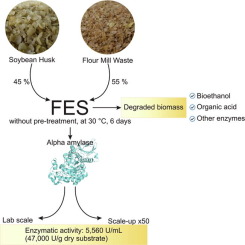Waste Management ( IF 8.1 ) Pub Date : 2020-03-25 , DOI: 10.1016/j.wasman.2020.03.025 Natasha Melnichuk , Mauricio J. Braia , Pablo A. Anselmi , María-Rocío Meini , Diana Romanini

|
The global amount of soybean and wheat produced is about 350 and 750 million metric tons every year, respectively. In consequence, huge amounts of waste are produced from them. The aim of this work was to employ two wastes -soybean husk and flour mill waste- to produce high quantities of alpha-amylase enzyme. The substrate composition and the culture conditions were assayed to improve alpha-amylase production by solid-state fermentation employing the fungus Aspergillus oryzae. The maximum productivity of the enzyme was achieved using a culture substrate composed of the two wastes, at 45% soybean husk and 55% flour mill by-product, without pre-treatment, at an incubation temperature of 30 °C. The optimal incubation time (6 days), yielded a very high alpha-amylase activity (47,000 U/g dry substrate) at low-cost. The enzymatic extract obtained was characterized by LC-MS, providing a complete profile of the proteins produced during the solid-state fermentation on these two wastes. Then, the extract was purified in a single-step by size-exclusion chromatography and the recovery and the purification factor of alpha-amylase enzyme were about 83% and 6, respectively. The system was scaled up 50 times and yielded a similar enzymatic activity (45,900 U/g of dry substrate).
中文翻译:

通过固态发酵对两种农用工业废料进行增值以从米曲霉生产α-淀粉酶
每年全球大豆和小麦的产量分别约为350吨和7.5亿吨。结果,它们产生了大量的废物。这项工作的目的是利用两种废料(大豆皮废料和面粉厂废料)生产大量的α-淀粉酶。通过使用米曲霉真菌进行固态发酵来测定底物组成和培养条件以提高α-淀粉酶的产量。使用由两种废物组成的培养底物,在不进行预处理的情况下,在30°C的孵育温度下,使用45%的大豆皮和55%的面粉厂副产品组成的培养基,可以实现酶的最大生产率。最佳孵育时间(6天)以低成本产生了很高的α-淀粉酶活性(47,000 U / g干底物)。通过LC-MS对获得的酶提取物进行表征,以提供这两种废物在固态发酵过程中产生的蛋白质的完整概况。然后,通过大小排阻色谱法一步纯化纯化的提取物,α-淀粉酶的回收率和纯化因子分别约为83%和6。该系统按比例放大了50倍,并产生了相似的酶活性(45,900 U / g干燥底物)。


























 京公网安备 11010802027423号
京公网安备 11010802027423号